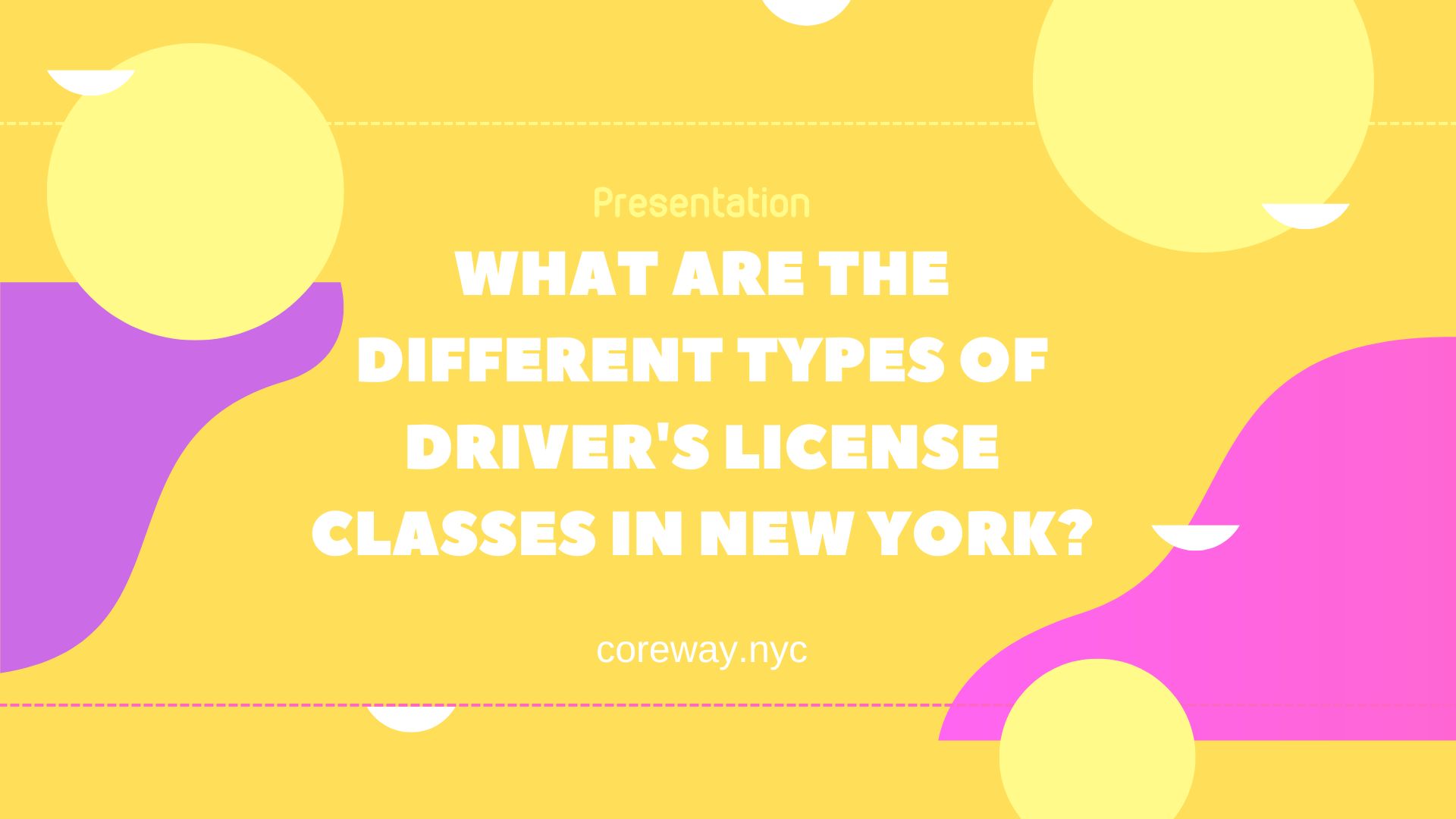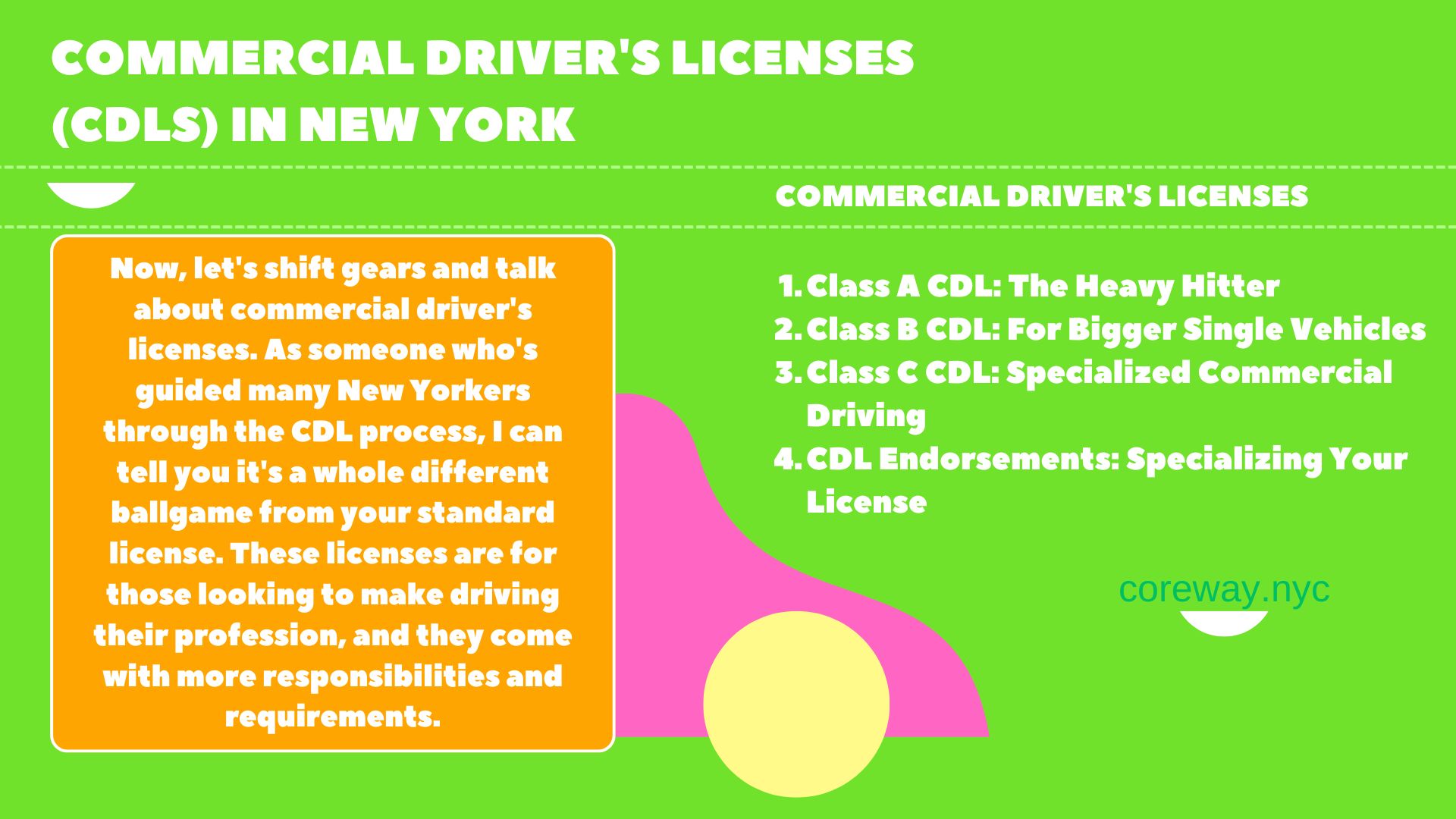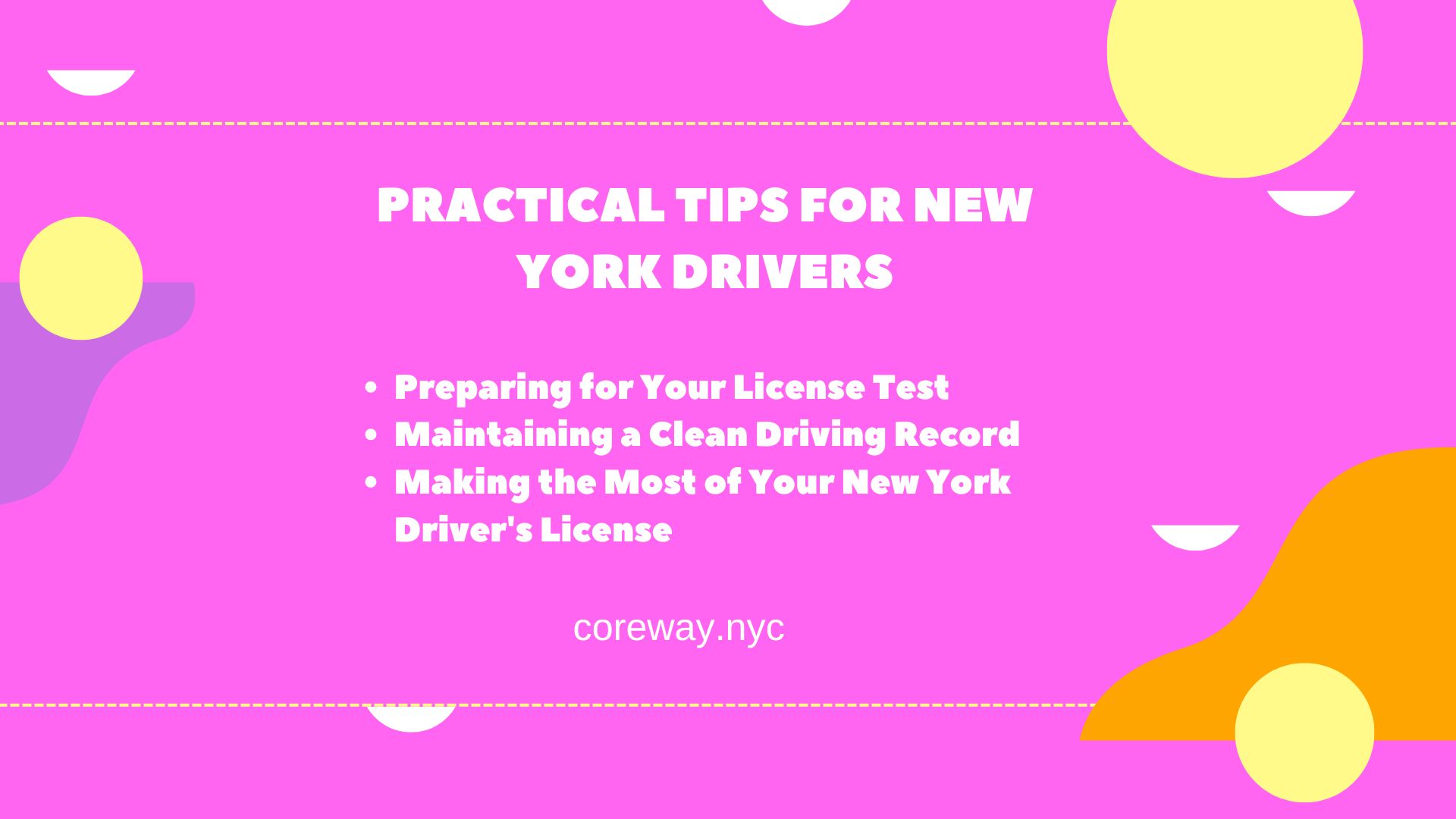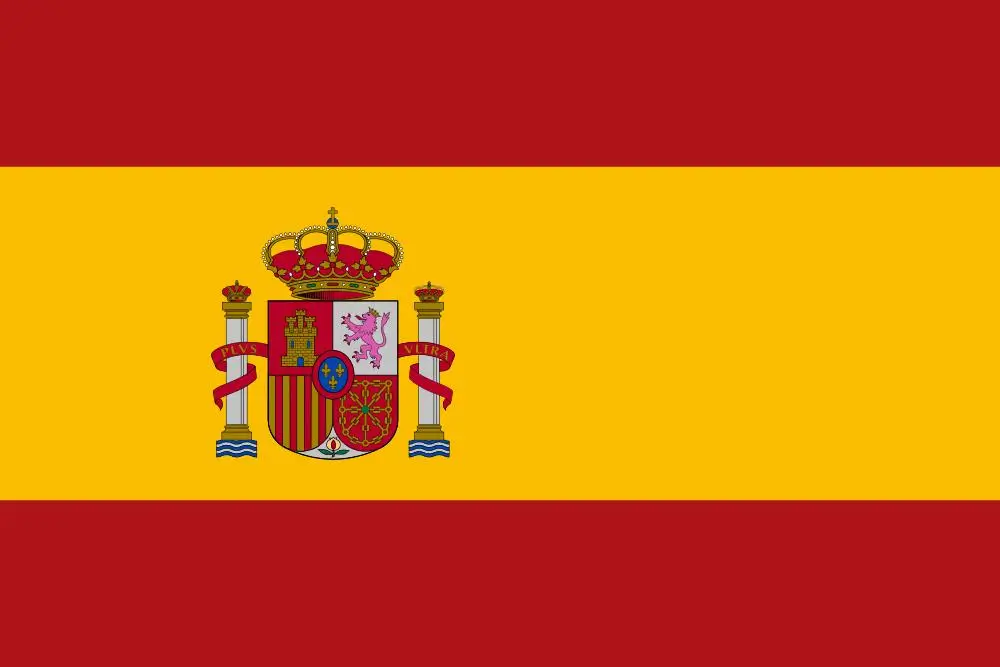What Are the Different Types of Driver's License Classes in New York?

Table of Contents
- Breaking Down New York's Driver's License Classes
- Non-Commercial License Classes
- Commercial Driver's Licenses (CDLs) in New York
- Class A CDL: The Heavy Hitter
- Class B CDL: For Bigger Single Vehicles
- Class C CDL: Specialized Commercial Driving
- CDL Endorsements: Specializing Your License
- Special Considerations for New York Drivers
- The Graduated Driver Licensing (GDL) System
- License Restrictions
- Upgrading Your License Class
- The Enhanced Driver's License (EDL)
- Practical Tips for New York Drivers
- Preparing for Your License Test
- Maintaining a Clean Driving Record
- Making the Most of Your New York Driver's License
If you're looking to hit the roads in the Empire State, you'll need to know about the various driver's license classes available. New York offers a range of license types, each tailored to different driving needs and vehicle types. As someone who's guided countless New Yorkers through the process of getting their licenses, I can tell you that understanding these classes is crucial, whether you're aiming to cruise down Broadway in a sedan or navigate a big rig through the Adirondacks.
In New York, driver's licenses are divided into two main categories: non-commercial and commercial. The most common non-commercial license is the Class D, which allows you to drive a standard passenger vehicle. But that's just the tip of the iceberg. From there, we've got specialized classes for motorcycles, taxis, and even junior drivers. On the commercial side, we're looking at Classes A, B, and C, each permitting the operation of progressively larger and more complex vehicles.
Now, you might be wondering why all these classes matter. Well, each class comes with its own set of rules, restrictions, and responsibilities. Getting the right license isn't just about legal compliance; it's about ensuring you have the skills and knowledge to safely operate the vehicle you're driving. Whether you're a teenager eager to get behind the wheel for the first time or a seasoned driver looking to upgrade to a commercial license, understanding these classes is your first step towards achieving your driving goals in New York.
Call Us Today 6AM-10PM
Or fill out the form 24/7
Our team is here to guide you with promotions, instructor availability, and the best training package for you.
Breaking Down New York's Driver's License Classes

Let's dive into the specifics of each license class in New York. As someone who's helped folks from Buffalo to Montauk get their licenses, I can tell you that understanding these distinctions is key to navigating the roads legally and safely.
Non-Commercial License Classes
Class D: The Standard Driver's License
This is the license most New Yorkers are familiar with. If you're 18 or older and want to drive a car, SUV, or small truck for personal use, this is your go-to license. With a Class D, you can:
- Operate any vehicle weighing less than 26,000 pounds
- Tow a vehicle, but the combined weight can't exceed 26,000 pounds
Here's a pro tip: If you're under 18, you'll start with a Class DJ (Junior Driver) license, which has some restrictions. More on that in a bit.
Class E: For-Hire Driving
If you're eyeing a career as a taxi driver or want to drive for a rideshare service in New York City, you'll need a Class E license. This allows you to:
- Drive vehicles for hire that can carry up to 14 passengers
- Operate ambulances and other emergency vehicles
Getting a Class E license requires a clean driving record and passing a special exam. It's a step up from the Class D and opens doors to professional driving opportunities.
Class M: Motorcycle License
For all you motorcycle enthusiasts out there, the Class M is your ticket to ride. This license is specifically for operating motorcycles and mopeds. You can get this as a standalone license or add it as an endorsement to your existing license.
Remember, in New York, we take motorcycle safety seriously. You'll need to complete a Motorcycle Safety Course or pass both a written and road test to get this license.
Class MJ and DJ: Junior Licenses
These are special licenses for our younger drivers:
- Class DJ (Junior Driver): For drivers aged 16-17, allowing them to drive cars and trucks with some restrictions.
- Class MJ (Junior Motorcycle): Similar to the DJ, but for young motorcycle riders.
These junior licenses come with restrictions like limited night driving and passenger limits. They're designed to help young drivers gain experience safely before graduating to a full license.
Call Us Today 6AM-10PM
Or fill out the form 24/7
Our team is here to guide you with promotions, instructor availability, and the best training package for you.
Commercial Driver's Licenses (CDLs) in New York

Now, let's shift gears and talk about commercial driver's licenses. As someone who's guided many New Yorkers through the CDL process, I can tell you it's a whole different ballgame from your standard license. These licenses are for those looking to make driving their profession, and they come with more responsibilities and requirements.
Class A CDL: The Heavy Hitter
This is the top-tier commercial license in New York. With a Class A CDL, you're qualified to operate:
- Tractor-trailers
- Truck and trailer combinations
- Tanker vehicles
- Livestock carriers
Essentially, any combination of vehicles with a gross combined weight rating (GCWR) of 26,001 pounds or more, including a towed vehicle weighing over 10,000 pounds. It's the license you need if you dream of hauling big loads across the country.
Getting a Class A CDL isn't easy, but it's rewarding. You'll need to pass both a knowledge test and a skills test. The skills test includes a vehicle inspection, a basic control test, and a road test. It's challenging, but don't let that intimidate you. I've seen plenty of determined New Yorkers ace these tests with proper preparation.
Class B CDL: For Bigger Single Vehicles
A Class B CDL is perfect if you want to drive larger vehicles but aren't interested in long-haul trucking. With this license, you can operate:
- Straight trucks
- Large buses (including city buses and tourist buses)
- Segmented buses
- Box trucks (like delivery trucks)
- Dump trucks with small trailers
The key difference from Class A is that Class B is for single vehicles with a GVWR of 26,001 pounds or more, or a vehicle towing another vehicle weighing up to 10,000 pounds.
Class C CDL: Specialized Commercial Driving
The Class C CDL is a bit different. It's for smaller vehicles that don't meet Class A or B criteria but are used for specific commercial purposes. You'll need a Class C CDL if you're going to:
- Drive a vehicle designed to transport 16 or more passengers (including the driver)
- Transport hazardous materials (requires a special endorsement)
This could include passenger vans, small HAZMAT vehicles, and some delivery trucks.
CDL Endorsements: Specializing Your License
Once you have your CDL, you can add endorsements to expand what you're qualified to do. Some common endorsements in New York include:
- H: Hazardous Materials
- N: Tank Vehicles
- P: Passenger Vehicles
- S: School Buses
- T: Double/Triple Trailers
Each endorsement requires additional testing, but they can significantly increase your employment opportunities.
Remember, getting a CDL in New York also means meeting federal requirements. You'll need a clean driving record, pass a medical exam, and be at least 18 years old (21 for interstate driving or hazardous materials transport).
In my experience, many drivers start with a Class B or C and work their way up to a Class A. It's a journey, but it's one that can lead to a rewarding career on the road. Whether you're looking to drive a school bus in Syracuse or haul goods from NYC to LA, there's a CDL class that fits your goals.
Special Considerations for New York Drivers
As we navigate the landscape of driver's licenses in New York, there are some unique aspects and special considerations that every driver should be aware of. Having guided countless individuals through the intricacies of the New York DMV system, I can tell you that understanding these nuances can make your driving journey much smoother.
The Graduated Driver Licensing (GDL) System
New York takes the safety of young drivers seriously, which is why we have the Graduated Driver Licensing system. This system is designed to ease new drivers into the responsibilities of the road gradually. Here's how it works:
- Learner Permit: This is where everyone starts. You can get your permit at 16, and it allows you to practice driving under supervision.
- Junior License (Class DJ): After holding your permit for at least 6 months and completing 50 hours of supervised driving (including 15 hours at night), you can take your road test. If you pass, you'll get a Junior License. This comes with restrictions:
- No driving between 9 PM and 5 AM unless it's for work, school, or with a parent/guardian.
- Only one passenger under 21 who isn't an immediate family member.
- Full License: At 17, if you've completed a driver's education course, or at 18 without the course, you can convert your DJ license to a full Class D license.
I've seen many young drivers frustrated by these restrictions, but trust me, they're there for a reason. They give you time to build experience and confidence on the road.
License Restrictions
Restrictions aren't just for junior drivers. Depending on your circumstances, your license might have specific restrictions. Some common ones in New York include:
- B: Corrective lenses required
- Vehicle modifications required (like hand controls)
- F: Outside rearview mirrors required
- G: Daylight driving only
These restrictions are there to ensure you can drive safely. If you need to have a restriction removed, you'll need to demonstrate to the DMV that it's no longer necessary.
Upgrading Your License Class
Maybe you started with a Class D but now you're eyeing a career change that requires a CDL. Or perhaps you want to add a motorcycle endorsement to your existing license. Here's what you need to know about upgrading:
- Adding an Endorsement: This usually involves taking an additional knowledge test and sometimes a skills test. For instance, adding a motorcycle endorsement (Class M) to your license requires both a written test and a road test.
- Moving to a Commercial License: This is a bigger step. You'll need to:
- Get a Commercial Learner's Permit (CLP) first
- Pass a series of knowledge tests
- Complete a road test in the type of vehicle you want to be licensed for
- Meet federal requirements, including a medical exam
- Upgrading Within CDL Classes: If you have a Class B and want to move to Class A, you'll need to take additional tests and demonstrate your skills with the larger vehicles.
Remember, each upgrade or addition to your license opens new doors but also comes with new responsibilities. I always advise my clients to think carefully about their long-term goals before pursuing an upgrade.
The Enhanced Driver's License (EDL)
Here's something unique to New York and a few other border states: the Enhanced Driver's License. An EDL serves as both a driver's license and a document for entering the U.S. by land or sea from Canada, Mexico, and some Caribbean countries. It's not necessary for everyone, but if you frequently travel to these places, it can be a convenient option.
Understanding these special considerations can help you navigate the New York driving landscape more effectively. Whether you're a teenager just starting out, a seasoned driver looking to expand your skills, or someone considering a career change into commercial driving, knowing these ins and outs of the New York system is crucial.
Practical Tips for New York Drivers

After years of helping New Yorkers navigate the complexities of our state's driving laws, I've gathered a wealth of practical advice. Whether you're a newcomer to the Empire State or a lifelong resident looking to upgrade your license, these tips will help you make the most of your driving experience in New York.
Preparing for Your License Test
- Study Smart: The New York Driver's Manual is your bible. It's available online, but I always recommend getting a physical copy too. Highlight key points and make notes – it's not just about memorizing, but understanding.
- Practice Tests Are Your Friend: The DMV website offers free practice tests. Use them! I've seen countless students ace their written test because they familiarized themselves with the format and common questions.
- Hands-On Experience: For the road test, there's no substitute for practice. If you're a new driver, take advantage of the 50-hour requirement. Drive in different conditions – daytime, nighttime, rain (when safe). The more varied your experience, the more confident you'll be.
- Know Your Test Route: While the exact route can change, most test sites have a general area where they conduct road tests. Familiarize yourself with these areas, paying special attention to school zones, one-way streets, and tricky intersections.
Maintaining a Clean Driving Record
Your license is more than just permission to drive – it's a responsibility. Here's how to keep your record clean:
- Understand the Point System: New York uses a point system for traffic violations. Accumulate 11 points in 18 months, and your license could be suspended. Know what actions carry points – for example, speeding (3-11 points depending on how fast you're going) or using a mobile phone while driving (5 points).
- Take a Defensive Driving Course: Not only can this reduce your insurance premiums, but it can also remove up to 4 points from your license. It's a smart move, especially if you've had a minor infraction.
- Respect the Graduated License Restrictions: If you're a junior driver, follow those nighttime and passenger restrictions. I've seen too many young drivers lose their licenses because they thought these rules were flexible. They're not.
- Stay Sober, Stay Safe: New York has strict DWI laws. Even a first offense can result in license revocation. It's not worth the risk – to your license or to lives.
Learn if you can use a rental car for driving test appointments and avoid last-minute problems.
Making the Most of Your New York Driver's License
- Consider an Enhanced Driver's License (EDL): If you live near the Canadian border or frequently travel to Canada, Mexico, or the Caribbean, an EDL can be incredibly convenient. It's a bit more expensive, but it serves as both a driver's license and a border crossing document.
- Keep Up with Renewals: New York licenses are generally valid for 8 years. Mark your renewal date on your calendar – driving with an expired license can lead to fines and even license suspension.
- Update Your Address: You're required to notify the DMV within 10 days of changing your address. It's easy to do online and ensures you don't miss important communications.
- Explore Career Opportunities: If you're interested in driving professionally, consider the career paths opened up by different license classes. From local delivery services (Class D) to long-haul trucking (Class A CDL), your license can be a gateway to various career opportunities.
- Stay Informed: Traffic laws and DMV procedures can change. Follow the NYS DMV on social media or check their website periodically for updates. Staying informed can save you from unintentional violations.
Remember, your driver's license is both a privilege and a responsibility. By following these tips, you're not just protecting your right to drive – you're contributing to the safety of everyone on New York's roads.
Call Us Today 6AM-10PM
Or fill out the form 24/7
Our team is here to guide you with promotions, instructor availability, and the best training package for you.
Frequently Asked Questions About New York Driver's Licenses
-
Can I drive in New York with an out-of-state license?
Yes, you can. If you're visiting New York, you can drive with a valid license from your home state or country. However, if you become a New York resident, you're required to get a New York license within 30 days. This is a rule many newcomers overlook, so mark your calendar if you're moving here!
-
How long does it take to get a CDL in New York?
The timeline can vary, but typically, it takes about 7-8 weeks to complete a CDL training program. After that, you'll need to pass your tests at the DMV. Remember, you must be at least 18 for an intrastate CDL and 21 for interstate driving. From start to finish, allow 2-3 months to be safe.
-
Can I add a motorcycle endorsement to my existing license?
Absolutely! You don't need a separate license for motorcycles in New York. Instead, you can add a Class M endorsement to your current license. You'll need to pass both a written test and a road test specifically for motorcycles. I always recommend taking a motorcycle safety course – it can even waive your road test requirement in some cases.
-
What's the difference between a suspended and a revoked license?
This is a crucial distinction. A suspended license is temporary – you can't drive for a specific period, but your license will be reinstated after that time (and possibly after paying a fee). A revoked license, on the other hand, is canceled. If your license is revoked, you'll need to reapply as if you're a new driver once your revocation period ends.
-
Do I need a special license to drive a rental truck?
Generally, no. Most rental trucks (like U-Haul) can be driven with a standard Class D license. However, if the truck weighs more than 26,000 pounds, you would need a CDL. Always check the weight of the specific truck you're renting to be sure.
-
Can I use my New York driver's license to fly domestically?
As of now, yes, but this is changing. Starting May 3, 2025, you'll need a REAL ID-compliant license or another acceptable form of ID (like a passport) to fly domestically. If you're renewing or getting a new license, consider opting for a REAL ID or Enhanced Driver's License to save yourself trouble later.
-
How do I reinstate my license after a DWI in New York?
Reinstating your license after a DWI in New York is a complex process that varies depending on your specific situation. It's not a simple matter of waiting out your suspension or revocation period. The state takes DWI offenses very seriously, and even a first-time offense can result in your license being revoked for up to a year. Once your suspension or revocation period is over, you'll need to navigate a series of steps to get back on the road legally. This typically involves paying a reinstatement fee to the DMV, which can be substantial. You'll also need to enroll in and complete the New York Drinking Driver Program, which is designed to educate drivers about the dangers of alcohol and drug use while driving.
-
Can I have both a New York and an out-of-state license?
No, you can only have one valid driver's license at a time. When you get a New York license, you'll have to surrender any out-of-state licenses you hold.
-
How do I prepare for the New York road test?
Practice is key. Make sure you can perform all basic maneuvers: parallel parking, three-point turns, stopping at precise points, and backing up straight. Familiarize yourself with road signs and traffic laws. On test day, stay calm and remember to exaggerate your head movements when checking mirrors and blind spots – make it obvious to the examiner that you're being observant.
 English
English Spanish
Spanish 

